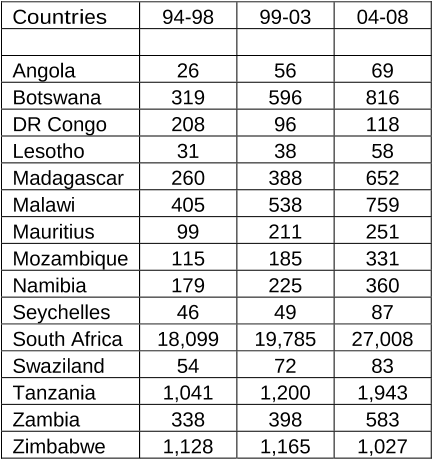




Did you find this useful? Give us your feedback











8 citations
...The leadership role of South Africa in contributing to Africa’s knowledge base has been documented [8, 33, 36], while South Africa, Egypt, Nigeria and Tunisia have been identified as major contributors to the growth of scientific publications in Africa [34]....
[...]
6 citations
...Besides this, those countries that have English as an official language usually have a colonial legacy with Anglo-Saxon countries (US, UK, Canada, Australia), and consequently have more Determinants of citation impact 49 collaboration with them (Mêgnigbêto 2013; Pouris 2010)....
[...]
...Scientific areas with higher potential to support innovation, such as engineering, material sciences, molecular biology and social science have been underrepresented in terms of scientific output (Juma 2016; Pouris 2010)....
[...]
6 citations
...The higher productivity and citation in applied scientific and technological fields, over those in the social sciences, also fits the known pattern for the tropics and for the world (Narváez- et al., 2002; Pouris, 2010; Mêgnigbêto, 2013)....
[...]
...In the 2000s, South Africa produced 79 % of African scientific publications (Pouris, 2010)....
[...]
6 citations
...1 3 Science category (Scholarly IPs) 2004- present 2004- 2008 2009- 2013 2014- present 1 3 In Yemen, Libya, Somalia, Mozambique and Afghanistan, the situation is different as the interest to Science in these nations was high in the 2004–2008 period before dramatically falling and finally disappearing in the 2014–2019 period (Figs....
[...]
...2017), Somalia (Ibrahim 2018) and Mozambique (Pouris 2010)....
[...]
...In Asia except former USSR and Africa, Science gradually lost ground to Nature and it currently attracts a major interest by scientific communities only in some countries like Papua New Guinea, Yemen, Mozambique and Angola (Fig....
[...]
4 citations
...The link is significant for developing countries and has recently been confirmed in the case of South Africa (see Inglesi-Lotz and Pouris, 2010)....
[...]
...…collaboration between Africans, it is often driven by non-African scientists (Mêgnigbêto, 2013; Quayle and Greer, 2014) based on former colonial ties (Confraria and Godinho, 2015) and output tends to be dominated by a single country in a region, like South Africa Community) (Pouris, 2010)....
[...]
...There is little research collaboration between Africans, it is often driven by non-African scientists (Mêgnigbêto, 2013; Quayle and Greer, 2014) based on former colonial ties (Confraria and Godinho, 2015) and output tends to be dominated by a single country in a region, like South Africa Community) (Pouris, 2010)....
[...]
1,113 citations
228 citations
187 citations
...‘‘These databases currently provide the best source of information to identify the basic research activity across all countries and fields of science’’ (Tijssen 2007)....
[...]
...Examples include Shrum (1997), Narvaez-Berthelemot et al. (2002), Ingwersen and Jacobs (2004), Tijssen (2007), Pouris (1996) and others....
[...]
159 citations
119 citations